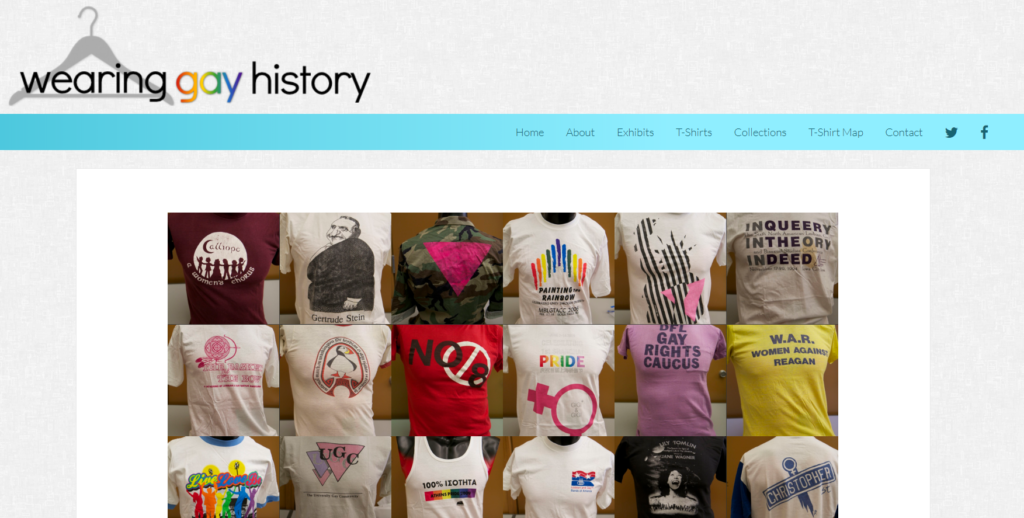
Wearing Gay History. http://wearinggayhistory.com/. Created and maintained by Eric Gonzaba and Amanda Regan, http://wearinggayhistory.com/about. Reviewed Jan. 2020.
The Wearing Gay History project is self-described as “A Digital Archive of Historical LGBT T-Shirts,” hosting the queer t-shirt collections of 14 different American archives. The digital archive contains shirts from the last 40 years of queer history, and showcases them using Omeka, a platform friendly to digital archiving. The website puts LGBT history in context with itself, defeating coastal biases and exhibiting the diversity of the queer community.
The site features over 4000 items that have been divided into 21 collections based on their origin. Users can search the items by a list of preset tags, by collection, or by detailed search using keywords, locations, and other signifiers. The images are not uniform in background color or mannequin, but these details don’t detract from the cohesiveness of the archive. The metadata includes a description of the creator, date, place of origin, subject, and a few other fields. Each item includes a citation and information about copyright, which is a great help for those wanting to refer to these t-shirts in their work.
The site also includes interpretation of its collections in the form of digital exhibits. These exhibits use the digitized t-shirts to inform about queer history by placing these shirts in context. Many of these shirts require context that non-experts don’t understand without explanation. The page “The Ones that Laughed: Humor in the LGBT Community” explains the necessary context of humorous t-shirts. For example, a t-shirt reading “Homo-Depot” is a play on a scandal involving the department store Home-Depot. The site uses this t-shirt to inform its audience about the history of anti-LGBT workplace policies during the 21st century .
The goals listed on the “About” tab are congruent with the digital products featured on the site. To counter bicoastal bias, the site includes a t-shirt map that shows that the bulk of the digital archive comes from inland. To examine the connection between distinct identities is the site uses a tag system, many items having multiple tags which span across differing identities. The goal of increasing visibility for small archives is met by the map as well, shirts grouped according to their archive of origin. Making these collections accessible to the public, this site brings queer history to the forefront of public consciousness. The site shows commitment to education by linking to other digital resources about the queer community, including articles and other digital archives.
While the site does well to reach the goals its set out, navigation and inclusivity serve as minor issues. While the tag system is helpful, the map is accessible, and there is a means of searching the shirts, the search feature is a bit intimidating, containing many fields that have little use for the non-expert. Additionally, this archive isn’t inclusive of many queer identities that have developed more recently. While the archive includes many examples of Lesbian, Gay, Bisexual, and Transgender t-shirts, it excludes (though not intentionally) the other identities that the expanded LGBTQIA+ features. Because, these identities are only beginning to gain visibility, it’s understandable that this archive of the past 40 years of queer history would face difficulty keeping finding materials representing all identities.
In all, this digital archive achieves its many goals through its diversity of materials, interpretation, and ease of use. This archive has clearly been curated by queer historians with a queer audience in mind. It uplifts the queer community, and makes often forgotten tales available at your fingertips.
